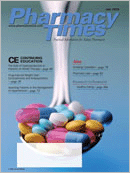Publication
Article
Pharmacy Times
Old Drug Interactions Harming New Patients
A report has appeared describinga 52-year-old heart transplantpatient on cyclosporine, azathioprine,and prednisone who wasadmitted to the hospital for life-threateningpancytopenia.1 It turned out that—without the knowledge of the transplantphysicians—the patient's primary physicianhad ordered allopurinol 300 mg dailyfor hyperuricemia. The ensuing drug interactionresulted in a dramatic increasein azathioprine effect, leading to a 31-dayhospital stay to treat the life-threateningdrug interaction at a cost of $181,000.
The irony of this current catastrophe isthat 35 years ago the same 2 drugs—azathioprine and allopurinol—resulted inthe death of a patient, and the eventreceived considerable attention in themedical and pharmaceutical literature.2For many pharmacists and physicianspracticing at the time, this 1970 case wasa needed wake-up call signaling thatdrug-drug interactions can cause seriousoutcomes and should not be ignored.But in the 34 years between the firstcase in 1970 and the recent report in2004, numerous patients on azathioprinehave developed life-threatening bonemarrow suppression after allopurinolwas added.3-5 The result has been considerabledistress or death for the affectedpatients and substantial cost to thehealth care system.
What Is the Nature of theInteraction?
Allopurinol inhibits the metabolism ofazathioprine by xanthine oxidase andcan substantially increase azathioprineplasma concentrations. The elevatedazathioprine concentrations can lead toazathioprine toxicity, primarily manifestedas bone marrow suppression. Theresultant reduction in white blood cellsand platelets can lead to adverse outcomessuch as infections and bleeding.
What Is the Time Course of ThisInteraction?
In most reported cases, complicationsfrom the drug interaction appearedbetween 1 and 2 months after the allopurinolwas added to the azathioprinetherapy. One should consider the possibility,however, that, in any given patient,adverse effects could be observed soonerthan 1 month or after 2 months.
How Can the Interaction BeManaged?
Those working with transplant patientsgenerally agree that this interactionis best avoided. Some have tried toreduce the likelihood of an adverse outcomeby reducing the dose of azathioprinewhen the allopurinol was added.5Nonetheless, even with substantial reductionsin azathioprine dose, somepatients still develop myelotoxicity.
Summary
The concurrent use of azathioprineand allopurinol has caused life-threateningand fatal adverse outcomes for severaldecades, and yet cases continue tobe reported. The adverse effects on thepatient are our primary concern, butthese serious reactions can also be verycostly: $181,000 in the recent case. Thefollowing recommendations may helpreduce the number of people harmed bythis drug interaction:
•Patients on azathioprine and otherimmunosuppressants should bestrongly advised not to take anymedications (prescription, OTC, oralternative) without checking withtheir transplant team first. Thisadvice should be repeated at regularintervals. Some of the reportedadverse outcomes from concurrentuse of azathioprine and allopurinolcould have been prevented if thepatients had followed the advice thatthey no doubt received about takingother medications.
•Pharmacists should be particularlycareful about drug interactions whendealing with transplant patients. Ifthere is any doubt about a possibledrug interaction, the patient's transplantteam should be contacted.Alert community pharmacists couldhave prevented some of the reportedadverse outcomes from the azathioprine-allopurinol interaction ifthey had inquired about medicationsthat the patient may have receivedfrom the transplant clinic.
•Computerized drug interaction detectionsystems need to be implementedthat will search all of themedications that each patient isreceiving. The risk of adverse druginteractions is increased when nosingle computer system has all of themedications. This risk would apply topeople who go to different pharmacies,such as those who get some oftheir medications from a pharmacyat a specialty clinic and other medicationsfrom a pharmacy in theircommunity.
Drs. Horn and Hansten are both professorsof pharmacy at the Universityof Washington School of Pharmacy.For an electronic version of this article,including references if any, visitwww.hanstenandhorn.com.
For a list of references, send astamped, self-addressed envelope to:References Department, Attn. A. Stahl,Pharmacy Times, 241 Forsgate Drive,Jamesburg, NJ 08831; or send an e-mailrequest to: astahl@ascendmedia.com.







